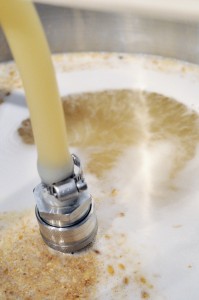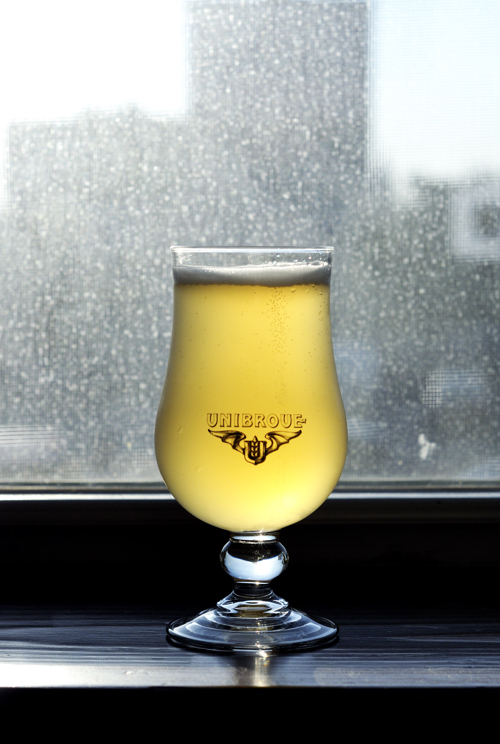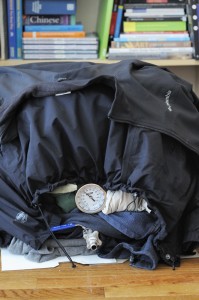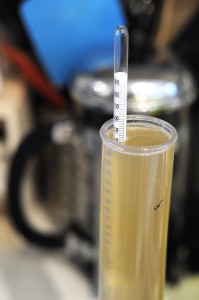My first batch of Berliner Weisse left me confident that sour mashing is a viable option for creating brightly acidic sour beers in short order. I’ve had a number of wonderful sour mashed beers along with quite a few terrible ones. A lot of people proclaim that sour mashing is a bit of a crap shoot, but I believe with careful process control, you can utilize sour mashing with a high success rate. It seems that the key to success with sour mashing is creating an environment that favors the lactic acid production you’re looking for while discouraging the growth of other bacteria and yeast that can easily fowl your mash with pretty horrific off-flavors.
My primary concerns are creating an anaerobic (no oxygen) environment, maintaining temperatures above 105°F, and pre-acidifying the mash. An anaerobic environment is achieved by thoroughly flushing the fermenter with C02 gas and then sealing the lid. Temperatures are maintained by insulating the mash tun and periodic hot water additions. Pre-acidification is achieved through a healthy dose of acidulated malt at the end of the mash regiment. After a 60 hour sour mash, the liquid was very tart and clean. There was no pellicle, mold, or otherwise odd looking growths on the surface of the mash. At this point in the process, you’re looking for a bright clean acidity — more similar to yogurt (lactic) than vinegar (acetic). If your mash smells or tastes like rotten vegetables, baby diapers, vinegar, or other funky flavors, your mash likely went off. Boiling and subsequent fermentation may drive off some of these offensive aromas, but chances are pretty slim that they will be eliminated completely.
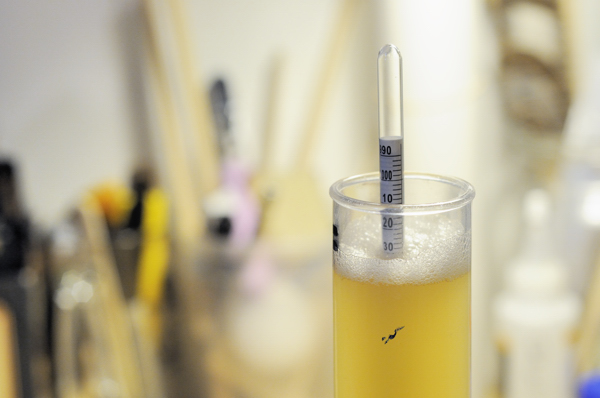 After sour-mashing I retrieved the soured wort and boiled it for 30 minutes to achieve a minor reduction in volume, kill any bacteria, and achieve a slight amount of bitterness. I cooled the wort and pitched Wyeast’s German Ale strain. I have heard antidotal evidence that low pH can adversely effect yeast fermentation.
After sour-mashing I retrieved the soured wort and boiled it for 30 minutes to achieve a minor reduction in volume, kill any bacteria, and achieve a slight amount of bitterness. I cooled the wort and pitched Wyeast’s German Ale strain. I have heard antidotal evidence that low pH can adversely effect yeast fermentation. I can offer my own contrary antidotal evidence — my low pH wort exhibited a very vigorous fermentation and attenuated well.
UPDATE 11/16/2013: After about 2 weeks in primary, I seem to be experiencing a pH related issue with this beer. Fermentation appeared extremely vigorous. It has however stopped at 1.010, which is most likely related to the beer’s low pH. At this point I am not comfortable bottling with a secondary Brett Trois strain. Instead, I have racked the beer to a secondary fermenter and pitched the Brett in an attempt to reach terminal gravity prior to packaging and bottle conditioning.
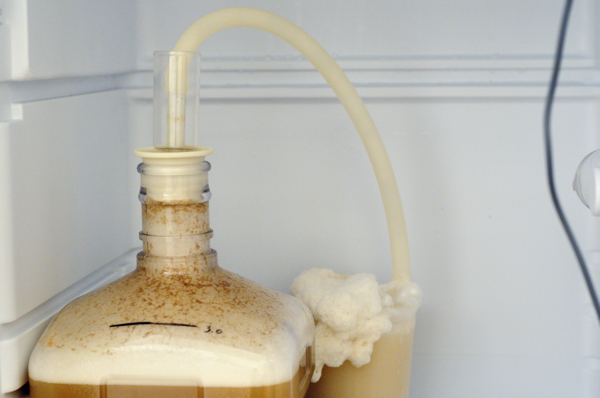
Wyeast describes the German Ale strain as a true top cropping yeast. Fermenting at 64°F created a large amount of yeast blowoff.
Recipe
Size: 3.25 gal
Efficiency: 68%
Attenuation: 80.0% (projected)
Boil Length: 30m
Original Gravity: 1.034 SG
Terminal Gravity: 1.007 SG (projected)
Color: 3.99 SRM
Alcohol: 3.59% ABV (projected)
Bitterness: 5.0 IBUs
Grist:
2 lb (43.2%) Bohemian Pilsner Malt (Weyermann)
2 lb (43.2%) White Wheat (Briess)
2 oz (2.7%) Victory® Malt (Briess)
8 oz (10.8%) Acidulated Malt (Weyermann) – 2oz during mash, 6oz to cap mash post sugar conversion
8 g Hallertauer Hersbrucker (4.3% AA) – 30m
0.5 ea Whirlfloc Tablets (Irish moss) – 15m
0.5 tsp Wyeast Nutrient – 10 m
WYeast 1007 German Ale™ – Primary Fermentation
White Labs WLP644 Brettanomyces Trois – Added to individual bottles during bottle conditioning. Ended up adding it in secondary before packaging.
Water Treatment:
Carbon filtered Brooklyn water (very soft) with 2g Gypsum and 4g Calcium Chloride added to mash.
Mash Regiment:
60m – 148 °F
10m – 154 °F
10m – 168 °F
Sour mash 60 hours:
1. Complete mash regiment above. Let mash cool to 128°F. Minimize stirring and aeration of wort.
2. Add 4 oz uncrushed grain & remainder of acidulated malt (6 oz).
3. Cover mash bed with aluminum foil, purge with CO2, and seal mashtun.
4. Insulate the mash tun and let rest for 60 hours.
5. Add boiling H2O to increase sour mash temp as required to keep above 105°F.
6. After 60 hours, increase mash tun temperature to 168°F and transfer wort to kettle.
Fermentation:
1. Chill to 64°F and keep at 64°F until activity slows (1 week+).
2. Raise temp to 68°F 2 days
3. Drop temperature to 32°F over the course of 4 days. Hold at 32°F for 2 days.
Packaging:
Prime with sugar as required to achieve 3 volumes of CO2. Inoculate half the bottles with Brett Trois (WLP644) for future side-by-side comparisons. Ended up adding the Brett to secondary in bulk prior to packaging.

